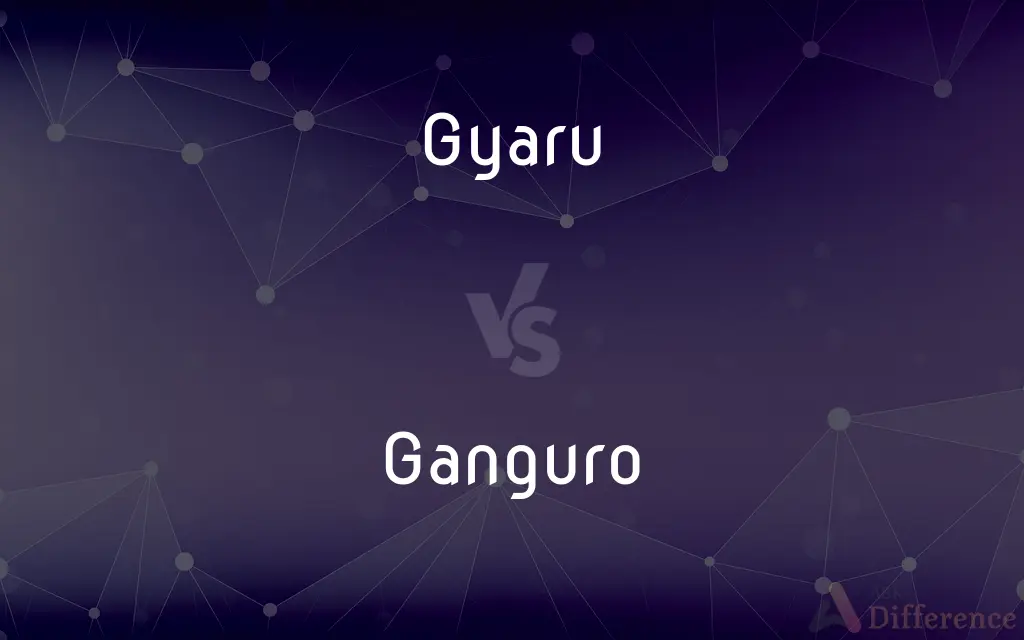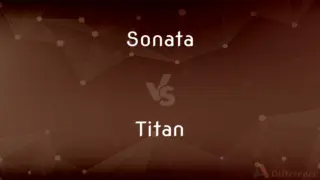Gyaru vs. Ganguro — What's the Difference?
By Urooj Arif & Maham Liaqat — Updated on March 10, 2024
Gyaru is a Japanese fashion trend characterized by rebellious, glamorous styles, often with dyed hair and dramatic makeup, while Ganguro, a subcategory of Gyaru, features extreme tanning, contrasting makeup, and colorful outfits.

Difference Between Gyaru and Ganguro
Table of Contents
ADVERTISEMENT
Key Differences
Gyaru fashion emerged in Japan during the 1990s as a statement against traditional Japanese beauty standards, showcasing a preference for westernized looks with dyed hair, artificial nails, and distinctive makeup. Ganguro, a more extreme subset of Gyaru from the late 1990s, took these elements further with deep tans, white makeup on the lips and around the eyes, and brightly colored outfits, creating a striking contrast.
The Gyaru style encompasses a variety of substyles, each with its own characteristics, ranging from the relatively subdued and feminine Hime Gyaru, with its princess-like aesthetics, to the more casual and wearable Kogal Gyaru, often associated with high school fashion. Ganguro, however, is more singular in its approach, focusing on the distinct look of dark tans and vibrant fashion, and is less varied than the broader Gyaru culture.
Culturally, Gyaru fashion is associated with a youthful rebellion against societal norms and an embrace of individuality and conspicuous consumption. Ganguro, as a part of the Gyaru movement, pushes these themes to an extreme, often attracting attention and controversy for its radical departure from conventional Japanese aesthetics.
The popularity of Gyaru fashion has seen various phases, with its peak in the 2000s and a gradual decline thereafter. Ganguro, in particular, saw a sharp rise and fall within this timeline, becoming less common in the 2000s as new trends emerged within the Gyaru culture and broader fashion landscapes.
Community and social aspects are significant in both Gyaru and Ganguro cultures, with followers often gathering in specific districts of Tokyo, such as Shibuya, to socialize and showcase their fashion. Magazines and social media have played crucial roles in the spread and evolution of these styles, creating a sense of belonging and identity among enthusiasts.
ADVERTISEMENT
Comparison Chart
Definition
A broad Japanese fashion trend characterized by glamorous, westernized styles.
An extreme subcategory of Gyaru with distinctive tans and colorful outfits.
Key Elements
Dyed hair, dramatic makeup, fashionable attire.
Deep tans, white facial makeup, vibrantly colored clothes.
Substyles
Includes Hime Gyaru, Kogal Gyaru, among others.
More uniform, with less variation compared to broader Gyaru.
Cultural Significance
Rebellion against traditional beauty standards, individuality.
Extreme expression of Gyaru, pushing societal norms further.
Popularity
Peaked in the 2000s, with a diverse range of substyles.
Had a specific peak in the late '90s and early 2000s, less common now.
Community
Strong community ties, with gatherings and shared media.
Part of the Gyaru community, with specific attention due to its distinctiveness.
Compare with Definitions
Gyaru
Known for its variety, from the princess-like Hime Gyaru to the more casual Kogal.
Her Hime Gyaru look was complete with a frilly dress and elaborate accessories.
Ganguro
Ganguro fashion is known for its vibrant and colorful attire.
The Ganguro style was evident in her neon outfit and bold accessories.
Gyaru
Gyaru fashion often includes heavy makeup, especially around the eyes.
Her makeup featured the dramatic eyeliner characteristic of Gyaru style.
Ganguro
Ganguro was particularly popular in the late '90s and early 2000s but has since become less common.
Ganguro, once a common sight in Shibuya, has become a rare find.
Gyaru
A Japanese fashion trend that diverges from traditional beauty norms, emphasizing westernized glamor.
She embraced the Gyaru style with her blonde hair and trendy outfit.
Ganguro
A distinctive substyle of Gyaru characterized by an extreme tan and contrasting makeup.
Her Ganguro look, with its deep tan and white makeup, turned heads.
Gyaru
Gyaru culture has a significant community aspect, with magazines and social gatherings.
She looked forward to the Gyaru meetup in Shibuya to connect with others who shared her fashion interests.
Ganguro
Despite its decline, Ganguro remains an iconic part of Gyaru culture.
Even though less prevalent, Ganguro is remembered as a significant phase in the evolution of Gyaru fashion.
Gyaru
The style promotes individuality and can be seen as a form of youthful rebellion.
Adopting Gyaru fashion was her way of standing out and expressing herself.
Ganguro
This style emerged as a radical form of self-expression within the Gyaru movement.
By adopting the Ganguro style, she embraced a more extreme form of rebellion against conventional norms.
Gyaru
Gyaru (Japanese: ギャル; Japanese pronunciation: [ɡʲa̠ꜜɾɯ̟ᵝ]) is a Japanese fashion subculture. The term gyaru is a Japanese transliteration of the English slang word gal.The term for gyaru was introduced in Japan by the American jeans company Lee, who introduced a new line of jeans to their brand Wrangler.
Ganguro
Ganguro (Japanese: ガングロ) is a fashion trend among young Japanese women that started in the mid-1990s, distinguished by a dark tan and contrasting make-up liberally applied by fashionistas. The Shibuya and Ikebukuro districts of Tokyo were the centres of ganguro fashion; it was started by rebellious youth who contradicted the traditional Japanese concept of beauty; pale skin, dark hair and neutral makeup tones.
Gyaru
A Japanese subculture and fashion style popular in the 1990s, typically involving ostentatious clothing, tanning, and heavy makeup.
Ganguro
A Japanese girl fashion trend involving dyeing the hair and tanning the skin.
Gyaru
A girl or woman of this subculture.
Common Curiosities
What was the cultural impact of Ganguro?
Ganguro challenged traditional beauty ideals in Japan, leaving a lasting impact on the dialogue around individuality and self-expression in fashion.
Can someone be Gyaru without being Ganguro?
Yes, one can adopt Gyaru fashion without embracing the Ganguro substyle, as Gyaru encompasses a wide range of looks.
Why did Ganguro fall out of popularity?
Ganguro's decline is attributed to changing fashion trends and the evolution of the Gyaru culture itself.
What distinguishes Gyaru from Ganguro?
Gyaru is a broad fashion trend, while Ganguro is a specific, more extreme substyle within Gyaru.
Is Gyaru fashion still relevant today?
While not as prominent as in its peak, Gyaru fashion continues to influence and maintain a presence in Japanese fashion.
Are there male equivalents to Gyaru and Ganguro?
Yes, there are male equivalents, such as Gyaru-o, though they differ in style and cultural context.
How do Gyaru and Ganguro styles reflect on Japanese society?
These styles reflect a segment of Japanese youth's desire to rebel against conventional norms and express individuality through fashion.
What role did magazines play in the Gyaru culture?
Fashion magazines were pivotal in spreading Gyaru and Ganguro styles, offering inspiration and a platform for community formation.
Can Gyaru fashion be considered a form of empowerment?
For many, adopting Gyaru fashion is a means of self-expression and empowerment, challenging societal expectations.
What are the key accessories in Gyaru fashion?
Accessories in Gyaru fashion often include exaggerated hair decorations, colorful nails, and distinctive jewelry, varying across substyles.
Share Your Discovery

Previous Comparison
Sonata vs. Titan
Next Comparison
Literately vs. LiterallyAuthor Spotlight
Written by
Urooj ArifUrooj is a skilled content writer at Ask Difference, known for her exceptional ability to simplify complex topics into engaging and informative content. With a passion for research and a flair for clear, concise writing, she consistently delivers articles that resonate with our diverse audience.
Co-written by
Maham Liaqat















































